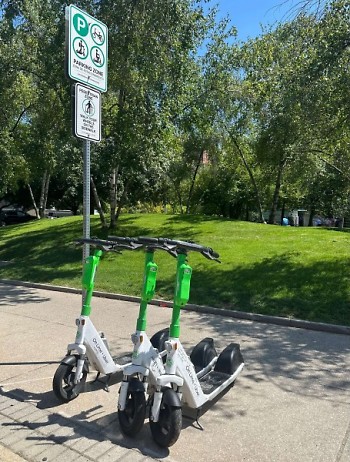The City of Grand Rapids and Lime, the e-scooter and e-bike company, are teaming up to improve access to affordable micro-mobility options by giving free rides to eligible residents.
The Lime Access pilot program, announced by the city in July, will allow eligible residents up to five free 30-minute rides a day for the duration of the pilot program.
To qualify, individuals must meet certain income requirements and be enrolled in state, city, or federal assistance programs such as Supplemental Nutrition Assistance Program Electronic Benefits Transfer (SNAP EBT), Temporary Assistance for Needy Families (TANF), Women, Infants, and Children (WIC), or the HUD Housing Choice Section 8 Vouchers.
“Our main goal for this program is to remove the cost barrier associated with shared e-bike and e-scooter use. This program offers reliable and convenient transportation options to individuals who may not have access to a car or other reliable means of getting around,” Mobile GR spokesperson Trent Cerra told The Rapidian when asked about the program.
The pilot program works by subsidizing the remaining 50% of the fare that the Lime Access discount leaves for riders. Mobile GR has dedicated $100,000 to fund the pilot program, which will remain in effect until all funds have been spent.
Since its launch on July 22, over 700 individuals have completed the Mobile GR survey and 300 of those respondents have been accepted into the Lime Access program. In just four days, 350 scooter or e-bike trips have been covered by the pilot program, more than doubling Lime Access numbers the previous month.
The Lime Access program has existed since the shared mobility company was approved to operate within Grand Rapids in 2021, but this recent expansion is getting more Grand Rapidians on wheels.
Mobile GR, the city department facilitating and funding the expanded pilot program, has noticed that previous participation in the program has been low. Despite peak months seeing as many as 20,000 unique rides, only about 100 of those rides were through the Lime Access program.
In 2022, Lime implemented its equity zone pricing that automatically discounted fares by 30% in areas that would benefit from more affordable mobility options, including Roosevelt Park, John Ball Park and Garfield Park.
“We believe that this program will not only improve mobility options but also enhance the quality of life by making it easier for people to commute, run errands, and participate in community activities,” said Cerra.
After the pilot program concludes, Mobile GR, alongside McGill University, will use the findings to see how equity and accessibility can be used in the future for shared mobility programs.
So far, response from community organizations has been positive.
“Freedom of choice is what this country is all about. Right now we don’t have all the choices for mobility,” says Ken Miguel-Cipriano, the co-chair of the transportation committee of the Kent County Emergency Needs Task Force (ENTF). “This is one step or component that leads to bigger shifts in how we see transportation in this city.”
Transportation is the second-most important budget item in a household after rent or mortgages, said Miguel-Cipriano.
“The pilot program is a positive step in the right direction but there still is a need to get the word out about this program and educate riders on how to use the devices. Some residents view scooters as pesky but with the proper education, I think the community has a lot to benefit from shared mobility,” said Michael Williams, another co-chair of the ENTF transportation committee.
Some residents use the the e-scooters and bikes for enjoyable trips across downtown on weekend nights while others rely on shared micromobility to get to work or as a quick option to get to a bus stop.
From the City’s press release, “over 266,000 unique riders have taken over 832,000 rides on Lime shared e-scooters and e-bikes. Lime riders have traveled over 1.2 million miles and have kept an estimated 204,000 car trips off the road. By shifting some trips from cars, Lime riders have prevented an estimated 104 metric tons of carbon emissions and saved an estimated 11,700 gallons of gas.”
Boosting multi-modal transportation options aligns with GR Forward, a community plan and investment strategy started in 2015 that aims to improve the quality of life in Grand Rapids and increase accessibility. Goal three of the plan tasks Grand Rapids to “implement a 21st Century Mobility Strategy” that utilizes other modes of transportation besides automobiles.
To see if you're eligible for the Lime Access pilot program
The Rapidian, a program of the 501(c)3 nonprofit Community Media Center, relies on the community’s support to help cover the cost of training reporters and publishing content.
We need your help.
If each of our readers and content creators who values this community platform help support its creation and maintenance, The Rapidian can continue to educate and facilitate a conversation around issues for years to come.
Please support The Rapidian and make a contribution today.
